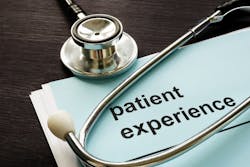When Baptist Health South Florida named Patricia Rosello, M.S.N., R.N., to the newly created position of chief patient experience officer in March 2022, she joined a growing number of C-level executives nationwide charged with rethinking elements of the health system from the patient perspective.
A nurse by training, Rosello had previously served as CEO of Baptist Hospital and CEO of Baptist’s outpatient division. When overseeing the outpatient division, patient experience came to the forefront, she says, because Baptist was competing with other retail operations on convenience, which is a key focus when trying to survive in the retail side of healthcare. As the chief patient experience officer, she started questioning why they couldn’t bring this same perspective into other aspects of healthcare, such as the emergency room or inpatient settings. In this role, she stresses that it is crucial to have a passion to see things from a patient's perspective.
“You have to have the willingness and desire to meet the patient where they are, and you have to cut across all boundaries,” Rosello adds. “You have to work with digital, marketing, physicians and operations. Your ability to influence and be very collaborative is going to be key because it takes all these different relationships to make any journey a better journey for a patient. You have to have that broad perspective, and a high level of empathy and understanding.”
Across the healthcare sector, there doesn’t appear to be much consistency in terms of who executives in this new role report to or what they are responsible for. In some health systems, there is responsibility for both patient and employee engagement, while others tie quality and patient experience together. “Typically, you see people report to marketing, human resources or strategy, Rosello says. “Here at Baptist, I report to the chief strategy officer, because for us experience is the No. 1 strategic initiative. And because of where I came in in my previous roles, I have great relationships with all these departments and with medical staff and with clinical leaders.”
Jon Freedman, a principal with The Chartis Group, a Chicago-based consulting firm, working within the digital transformation practice, says he has seen the chief patient experience officer role evolve. Initially they were specifically hospital-based and focused on inpatient experience.
“A lot of efforts were led by individuals or small groups and were episodic patient engagement,” Freedman notes. An individual came in with a problem and the focus was on their experience through that care regimen or treatment and once the patient was in a better place, the focus was lost. Today, he says, the patient experience team is focused on their entire healthcare journey, and the role itself is evolving to be more organization-wide and the patient experience officer is a senior leader.
Coming from diverse backgrounds
Chief patient experience officers come to the role from diverse backgrounds. While Rosello is a nurse, Lisa Allen, Ph.D., chief patient experience officer at Johns Hopkins Medicine, is a medical anthropologist by training, and her research has focused on the family experience. “I got into the world of quality and statistics and research in a hospital setting. A lot of people were just studying the disease process, and I was asking how it was affecting people's lives,” she says. “The Hopkins role allows me to focus on that which I felt most passionate about, which was really being patient- and family-centered.”
Allen says people in this new role have started to connect and share their experiences. The nonprofit Beryl Institute has a chief patient experience officer group bringing together leaders from many healthcare systems. “Our structures are different, in terms of who we report to, and who reports to us,” Allen says. “Some people have a really wide array of areas that report to them, and some people are a little bit more focused. For me, it's the whole patient experience: the analytics piece, the performance improvement piece. I have a team of coaches who support service lines; I also have patient relations and guest and volunteer services.”
Allen believes the title and where the position sits within the organization are important. “I think ‘chief’ in the title gets you into the boardroom, and it gets you to the management team, the other C-level individuals,” she explains. “I report to the senior vice president for quality and safety, and I have a dual report to the chief nurse for the health system.”
As an example of the type of project she takes on, Allen says, “We really needed a wayfinding system in our hospitals, so I worked with the leadership team to help implement that.”
Freedman stresses that people taking on this role should have a keen understanding and empathy for all of the pressures, particularly recently, on the workforce, and an understanding of how happier patients can and should beget a happier workforce and improved morale and employee retention.
Another important trait, he says, is empathy for consumers. “A person really has to know what consumers think, what consumers care about, and what it means to care for different types of consumers in different types of ways and then tell stories around what consumer experiences might mean for consumers and what it might mean for your organization,” Freedman says. The chief patient experience offer also needs to “support the broader organization, including changing operations, coordinating work with the chief information officer to ensure technologies are in place and utilized on an enterprise level to support consumer experience initiatives that support things like design thinking exercises, and have other tools in their toolkit to be able to really drive initiatives forward.”
Partnering on digital health
Rosello oversees three teams: care experience, data, and digital health. The digital health team serves as a bridge between what the patient experience team thinks they need to improve on in the digital experience and Baptist’s IT teams.
Baptist has a digital app that allows users to make appointments and order medications. “We are continually evaluating the product, getting feedback, and then translating that to the CIO and to the CTO as to what could we do to make it easier, more intuitive and more valuable to the patient, or their family and to get people enrolled,” Rosello explains. Those are collaborative conversations. “We might be the dress designer, but they have to make the dress. They may come back and say, that is a great idea, but there's no way our legacy system can do that. But here are some alternatives. I think it's probably one of the most collaborative relationships we have, because we see things and then they have to tell us whether it can be done or not, and we have to go back and forth to build it.”
At Johns Hopkins, Allen sits on several committees involved in technology implementations. For instance, there is a patient and family-centered MyChart portal committee. “We have 17 very active patient and family advisory councils throughout our system,” she explains, “and we have a consortium of those councils that gets together at the system level to learn from each other and understand best practices. We regularly ask that people who are considering implementing something that will touch the patient or the family come to these councils early in the development of whatever they're working on, and get input and then engage us along the way.”
Spending time in the call center
Stacey Parkin has been chief patient experience officer at MultiCare Health System in Washington state, for the past year and has been with the organization for 11 years. For her, improving patient experience is personal. “Having a child with a congenital heart defect and a mother with MS, I have navigated the healthcare system for years and wanted to make it better from the inside out. I am passionate about my work and making the experience more seamless and personal for people like my son and my mother,” she says in an e-mail interview.
In her role, Parkin spends the majority of her time with operations. “That is where the patient experience happens. It is where appointments get made, care gets delivered, and clinical outcomes occur,” she says. “I need to understand how the patient is experiencing us in real time — the impact of decisions on the front lines, and the challenges in delivering an exceptional experience. There is no better way to get that information than sitting in our call center, rounding on our patients and meeting with leaders and clinicians wo are delivering care.”
Parkin helped spearhead MultiCare’s rounding efforts on both patients and staff. “Partnering with a patient engagement platform has allowed us to conduct an ongoing roll-out of patient and staff rounding across various departments and locations among our network of hospitals, giving us critical insights into patient and staff wellbeing,” she says. “This has been crucial especially in light of the ongoing prevalence of hospital staff burnout.”
Embedding consumerism into the DNA
Terri Hanlon-Bremer, M.S.N., R.N., was named Cincinnati-based TriHealth’s chief operating officer in June 2022 after previously serving as senior vice president of employer solutions and population health. She said the main evolution in patient experience has been that the patient is now viewed as a consumer.
“That means that their voice really makes a difference. As one goes down the population health journey or journey to value, part of your metrics surround what that patient experience is, so it's no longer just taking care of the patient and getting good quality care,” she says. “The patient has to actually feel like they got a good experience in the process.”
She gave an example of a pilot project TriHealth began working on seven years ago to do psychographic segmentation: understanding how people are motivated, what their attitudes are, what their personalities are, and especially how they receive information or communicate. “What we found is that by integrating psychographics into our health coaching model, we were able to increase outcomes on health coaching behavior significantly and reduce health risks, so that this person could land in a better, healthier state.”
She said TriHealth has discovered that “by embedding consumer-centric tools and practices and embedding consumerism into our DNA and culture as an organization, we started changing the patient experience. We were getting people into healthier states while also improving healthcare outcomes, and ultimately also reducing some cost for that individual and either the government if CMS is the payer or for an employer if the employers pay.”
TriHealth has a director of patient experience on staff, according to Hanlon-Bremer, who adds that “I think the whole retail environment and the Amazon experience—on-demand instant gratification—has changed our world. Our younger generations are challenging us to think differently. Patient experience is not only around just, ‘Are you satisfied with our services?’ but ‘What can we do to delight you so that you then stay with us?’ And if you stay with us, then you'll share that within your span of influence, and then they'll [new patients] come to us. So not only are we doing the right thing by that person, but now we're gaining market share or population share.”
A focus on health equity
The recent heightened focus on health equity has put another responsibility on some chief patient experience officers’ plates.
“How we slice and dice the data is important,” Johns Hopkins’ Allen says. “Even though we try to understand the data on race, socioeconomic factors and education levels, some people are still underrepresented based on who we serve and who fills out the kinds of surveys we do. If we really want to hear the voice of a diverse population, we've got to send a survey to them in a way that they're comfortable answering it, and that is easy. We definitely are involved in health equity work.”
Rosello says Baptist Health South Florida’s quality teams are starting to look at health equity. “We will absolutely be participating in that process to truly understand where the care gaps are,” she adds. “I don't think patient experience can be outside of that work. You can't be providing a great experience if you don't know the nuances of your particular demographic.”


